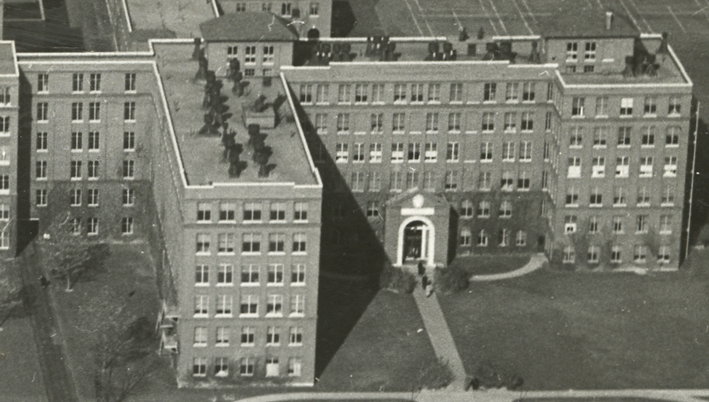
The roadway and entrance on the left side of the connecting structure is the Ambulance Entrance.
| Medical Center | Rochester Municipal
Hospital |
 |
| Rochester Municipal
Hospital in November 1933. The roadway and entrance on the left side of the connecting structure is the Ambulance Entrance. |
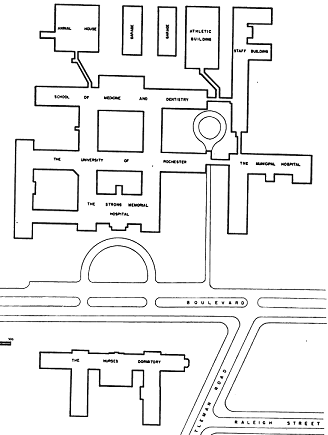 |
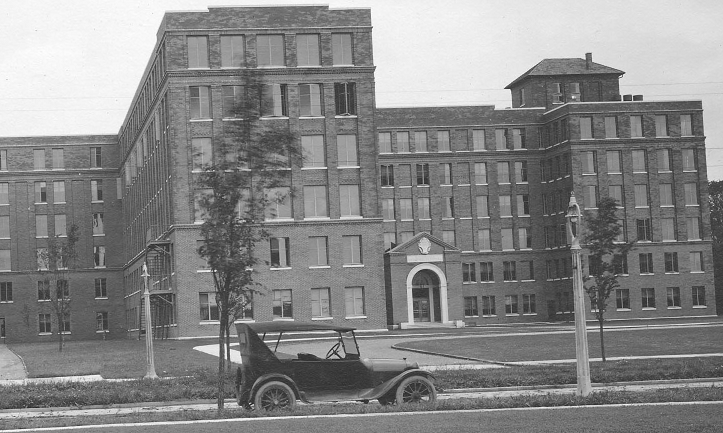 |
| Plot Plan from Hospital
Planning, by Charles Butler and Addison Erdman (1946) Page 118 |
Rochester Municipal
Hospital and Entrance around 1926. The bricked-in remnants of the old entrance can be seen from the G-4100 corridor. |
| Rochester
Municipal Hospital Floor Plans from Hospital
Planning, by Charles Butler and Addison Erdman (1946)
Page 125-128. Click on images for larger version |
|||
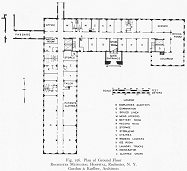 |
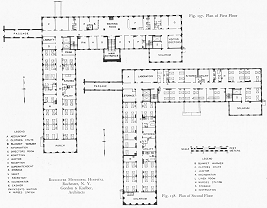 |
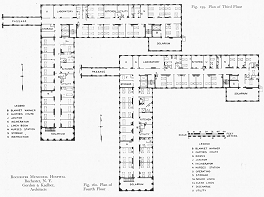 |
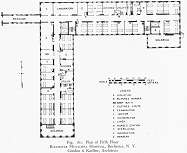 |
| Ground Floor |
First and
Second Floors |
Third and
Fourth Floors |
Fifth Floor |
The original Municipal Hospital, known as Hope Hospital, was established (as a result of an epidemic of smallpox in 1868) in a small century-old farm house on a triangle between the Erie and Lehigh Valley Railroad tracks, just north of the present River Boulevard. It consisted of an old two-story unsewered, lamp-lighted house, built about 1826, enlarged by the erection of two stove-heated wards capable of accommodating sixteen persons. It was known as the "pest house," and was quite inadequate in the epidemics which visited the city at frequent intervals. Finally after a smallpox epidemic of a thousand cases and one, hundred deaths in 1902, the Municipal Hospital on Waring Road was built and cared for the city's cases of acute infectious diseases for twenty years until it in turn proved unequal to the need.
During the year 1922, the Health Bureau of the City of Rochester had been busily engaged in drawing up plans for a new hospital to be erected on the Waring Road site. A new power plant and laundry for the Waring Road Hospital had in fact already been built to meet the added demands which would come with the erection of the new hospital. Soon, however, after the announcement of the foundation of the School of Medicine and Dentistry and its accompanying Hospital, Dr. George W. Goler, Health Officer of the City of Rochester, suggested to President Rhees and Mr. Eastman the great advantages to be gained by erecting the new Municipal Hospital adjoining and connecting with the Strong Memorial Hospital, using the Medical School faculty for the care of patients in the Municipal Hospital. Friendly negotiations were begun between the University and the City, represented successively by Mayors Hiram H. Edgerton and Clarence D. Vanzandt, which resulted in the signing on April 25, 1923, of a contract to run for fifteen years. This contract was drawn up by the late Walter S. Hubbell, of the firm of Hubbell, Taylor, Goodwin and Moser, and the erection of a new Municipal Hospital on Crittenden Boulevard was assured. It is well for all interested in the welfare of this community to read the twenty-third article of that contract.
It was decided that the Strong Memorial Hospital should contain about 250 beds and the Municipal Hospital the same number. Only 26 private rooms were then planned in the Strong Memorial Hospital. All service facilities such as kitchen, laundry, operating rooms, laboratories, X-ray department and stores were to be combined and located in the Strong Memorial Hospital, a plan by which, it was estimated, the City of Rochester would save approximately half a million dollars.
Construction was complete and the first patients were transferred from Waring Road on July 30, 1926.
By 1962 the City decided to get out of the hospital business and attempted to get Monroe County to take over the Municipal Hospital. The County was not excited about the prospect as it already ran the Monroe Community Hospital. A study by the Patient Care Planning Council recommended that the University take over the facility and operate it, which the University agreed to do. The city sold the hospital and 24 acres of land for $39,789, the same price the City had paid in 1923, and the University took over the facility on July 1, 1963. This transaction allowed the new Strong Memorial Hospital to be sited on the east end of the complex.
The Municipal Hospital building is largely intact and is now incorporated into the School of Medicine and Dentistry. The remains of the former main entrance can still be seen from the G-4300 hallway and there are still a few remnants of the facility, such as these signs (photographs taken in March 2022 and June 2023):
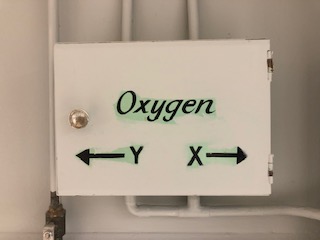 |
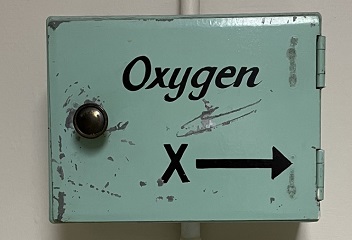 |
References (also see Disease,
Medicine, and Public Health references)
1921 "Plan
of Proposed Medical School and City Hospital," Democrat and
Chronicle, November 12, 1921, Page 27.
1921 "Co-operation
in University Plan in Urged," Democrat and Chronicle,
December 14, 1921, Page 26.
Building of Hospital; Subway under railroads.
1922 Proceedings
of the Common Council, for the City of Rochester, for 1922
Pages 568-570: Tuesday, October 24, 1922. Agreement between
the University of Rochester and the City of Rochester.
1922 "City
to Acquire Deed of Land to Build Hospital," Democrat and
Chronicle, October 26, 1922, Page 27.
Twenty-six Acres Will be Given by University on Completion of Plans.
1935 City
of Rochester Plat Book
Plate
39 and Plate
40 show the land owned by the city at the Municipal Hospital as
24.007 acres, with the widening of Elmwood Avenue and Crittenden Boulevard
reducing the original area of 26.5 acres..
1936 The First Decade 1926-1936
1941 "Enlarging
the existing connecting corridor between the Municipal Hospital and the
Strong Memorial Hospital," Democrat and Chronicle, May 31,
1941, Page 9.
This was apparently not done.
1950 Fifty Years of Health in Rochester, New York, 1900-1950, Albert D. Kaiser, M.D., Health Officer
1950 The First Quarter Century 1925-1950
1957 Planning and Construction Period of the School and Hospitals 1921-1925. bu George H. Whipple, M.D.| pdf |
1959 "Autobiographical
Sketch," by George Hoyt Whipple, Perspectives in Biology and
Medicine 2(3):253-289 (Spring 1959)
Describes the construction of the School and Hospital
1962 "UR Declares Inability to Absorb Added Costs of Aiding Needy Ill," Democrat and Chronicle, March 2, 1962, Page 15.
1962 "UR May Use City Hospital At Own Cost," Democrat and Chronicle, June 13, 1962, Page 23.
1962 "UR Operation of Hospital Recommended," Democrat and Chronicle, November 24, 1962, Page 19.
1962 "Municipal Slated
For Transfer to U of R," University Record 2(11):7 (December,
1962)
Current negotiations between the University of Rochester and the City
indicate that Municipal Hospital may be transferred to the UR effective
July 1, 1963.
1963 "UR
Offer Due As Only Bid For Hospital," Democrat and Chronicle,
June 11, 1963, Page 1B.
The City of Rochester will auction Municipal Hospital for a minimum price
of $39,789 on certain conditions. The auction and the price are to fulfill
certain technicalities in the plan agreed upon for the University of
Rochester to take over the city institution. The university, whose medical
center has operated the hospital under contract for 26 years, is expected
to be the only bidder. Conditions of sale include a requirement that the
purchaser use the hospital and its 24 acres for medical or educational
functions or for governmental public use. The buyer must agree to operate
the hospital as an in-patient care center for at least 15 years. Contract
Terms The expiring agreement, executed a year ago, provides that the city
will pay the university $39,789 after termination of the contract. That
was the price agreed upon for the land, situated between Elmwood Avenue
and Crittenden Boulevard, when the city first acquired the property. Thus,
the net cost of the property transaction to the university will be zero.
In addition, the city-university contract requires that the university
have two years' free use of the hospital after the agreement ends. An
auction is required for any city land not acquired by tax foreclosure.
1963 "Ordinance Approving Price for Sale of Land at Public Auction - Elmwood Avenue and Crittenden Boulevard," Democrat and Chronicle, June 28, 1963, Page 6B.
1975 To
each his farthest star: The University of Rochester Medical
Center -1925-1975, edited by Edward C. Atwater and John
Romano.
Page 239-240: Rochester Municipal Hospital
For several decades the administrative relationships between the Rochester
Municipal Hospital and the University Medical Center remained unchanged,
providing a basis for the excellent care of the community's indigent
patients and for research and educational opportunities for the students
and house staff at the Medical Center. With each succeeding year,
especially beginning in the 1950s, the cost of operating the Rochester
Municipal Hospital increased. By 1962 the city concluded that it could not
remain in the business of supporting a hospital for indigent patients. Dr.
Fenninger, in his role as medical director of Strong Memorial Hospital,
recognized the great opportunity the city's decision had for the future
development of the Medical Center. It was his foresight and effective
presentation of his perception of the opportunity that played a dominant
role in the University's decision to purchase the Municipal Hospital. As a
result, both the X and Y wings, which comprised the Rochester Municipal
Hospital, and the land that had originally been acquired from the
University by the city, some 13 acres extending eastward from the rest of
the Medical Center, were sold by the city of Rochester to the University.
When this transaction was completed, the administrative responsibility for
maintenance, housekeeping, and admissions in the Municipal Hospital was
transferred to Strong Memorial Hospital. All of the responsibility –
medical, operating, and fiscal – now rested with the University. Even
though these changes created a shift in responsibility and increased
workloads for some individuals, the transition was made without difficulty
and with an actual decrease in administrative personnel.
Of special note is the importance of the land that was purchased by the
University at the time of the transfer of the Rochester Municipal
Hospital. This land provided the site for the construction of the
completely new Strong Memorial Hospital to the east of the original
structures, thus allowing the original Hospital to function fully
throughout the construction phase of the new. The importance of this fact
cannot be overemphasized, since it made possible the uninterrupted care of
patients and the education of medical students, interns, and residents in
the old hospital during the five years when the new was under
construction. The land has also provided the space for the construction of
an apartment building, the Dr. George W. Goler House, to provide housing
for hospital employees, house staff, and students; and for the proposed
new Eastman Dental Center, that will move from its location downtown to
the campus of the Medical Center.
Thus, the transfer of the Rochester Municipal Hospital from the city to
the University had only a modest impact on the administrative functioning
of the Center, but it provided extremely valuable opportunities for
expansion of hospital facilities and will improve coordination of programs
with the Eastman Dental Center.
1977 History
of the University of Rochester, 1850-1962, by Arthur J.
May. Expanded edition with notes
Chapter 20, Shaping the Medical Center
Once the land had been legally transferred, plans for the construction of
the Medical Center moved forward at a good pace, though they had not fully
matured when an additional opportunity burst upon the scene--a municipal
hospital to be embraced in the medical complex. Since 1869 Rochester had
maintained a city hospital--or pesthouse--and under the dynamic leadership
of George W. Goler, two-fisted fighter for public health and city health
officer, blueprints had been drafted for a large new municipal hospital in
the northeastern section of Rochester. Community welfare would benefit,
Goler reasoned, if that project were abandoned and the municipal hospital
were attached to the U. of R. medical center. An arrangement of a similar
character had been worked out in Cincinnati, and it was estimated that the
city treasury would save $500,000 if the municipal hospital formed part of
the Crittenden Boulevard complex.
Rhees and Whipple responded enthusiastically to the Goler initiative,
which would at once enable the University to render a special service to
the community and would provide the School with patients suffering from
unusual or interesting ailments of value in training physicians. George
Eastman gave his approval to the idea, predicting that if it were carried
out, "The poorest family in Rochester will soon have the best available
medical and surgical skill." And the Mayor of Rochester, Hiram B.
Edgerton, not only strongly supported the proposal, but piloted the
necessary legislation through the municipal law-making body.
Negotiations between municipal and University officers to implement the
partnership resulted, on April 25, 1923, in a formal contract, which for
legality required an amendment to the city charter. Rhees termed the
agreement "the most noteworthy event" in U. of R. annals for the year. The
Municipal Hospital would be erected at city expense on a plot of ground
bought by the University with the understanding that if the contract was
not renewed the city would pay the U. of R. the purchase price of the
land. The municipality also agreed to finance the construction of an
underpass beneath the Lehigh Valley railway crossing Elmwood Avenue.
On its part, the University would furnish at cost the services of its
medical staff, diagnostic, x-ray, and operating facilities, pharmaceutical
products, food, heat, and laundry for patients, and would allocate space
for the City Health Bureau laboratories in the quarters of the department
of bacteriology. There tests would be made to determine the purity of milk
and water supplies and to detect infectious diseases. The contract, which
would run for fifteen years and was subject to renewal, served as a model
for similar pacts between municipalities and medical training institutions
all across the United States.
In the expert opinion of Abraham Flexner, the arrangement represented "one
of the most helpful steps ever taken in this country toward financing
medical education," and a praiseworthy prelude to creating clinics equal
to those in Europe. Rochester's city fathers he saluted as "enlightened
and far-sighted."
A bronze tablet in the Alumni Corridor of the Medical School, containing a
likeness of Goler, proclaims that "his concern for medical education and
for community health led to the construction of the Rochester Municipal
Hospital as an integral part" of the medical center. In recognition of his
indispensable role in translating vision into reality and as a testimonial
to his manifold and nationally acclaimed contributions to public health
and sanitation, the U, of R. in 1925 conferred upon him an honorary degree
in science.
© 2021 Morris A. Pierce